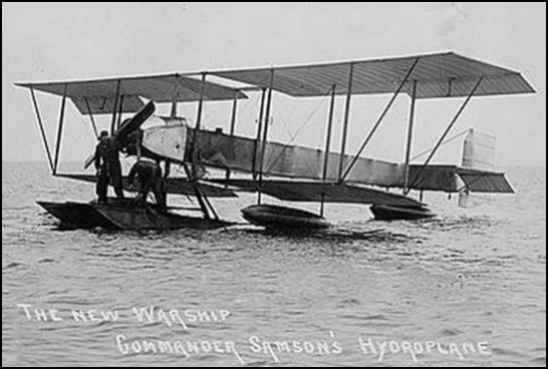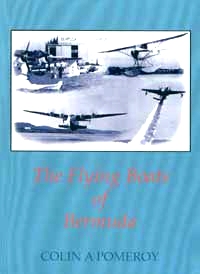
1883-1931 AKA Air Commodore Samson RAF - formerly Lt Cdr RNAS |
 |
|
at the Weymouth Naval Review, 6th May, 1912. Identification by The Archives Section, Fleet Air Arm Museum |
|
Extract from the book, courtesy of the author, Colin Pomeroy It was in Weymouth Bay, on 2nd May 1912, that this first took place - the vessel involved being HMS Hibernia, under the command of Captain Grafton which, like HMS Africa, was a 12" gun battleship of the King Edward VII class. When the warship was some three miles off the Portland Harbour breakwaters, and making towards them at some 5 knots, Lt Samson was launched over the warship's bows from a wooden platform on the foredeck and flew over the breakwaters and across Weymouth Bay to land at the conclusion of his flight at the eastern end of Lodmoor, adjacent to where the town's local racecourse was once located. The aircraft involved was a Short S38 'amphibian' (which would in those days have been known as a 'hydroplane'), a pusher biplane carrying the serial number T2 and fitted with a 70 hp Gnome engine, and one of two such aircraft belonging to the Naval Flying School at Eastchurch in Kent (with another two dual control models [an S43 and an S44] later being operated by the Central Flying School at Upavon, Wiltshire). Essentially a seaplane, the S38 had wheels incorporated in the floats to permit the aircraft to alight on land as well as in the water. This was a major historic event by any standards - although it was necessary for the aircraft to land alongside the Hibernia to be craned back aboard, for it was not until 2nd August 1917 that the first deck landing was achieved, when Squadron Commander E H Dunning landed his Sopwith Pup on the flight deck (which had no arrester wires) of HMS Furious. Sadly Dunning lost his life five days later when attempting another landing on Furious. Samson, however, was more fortunate and rose to the rank of air commodore in the, still at that time to be formed, RAF. He formed and commanded No 3 Squadron of the Royal Naval Air Service - which still exists today as No 203 (Reserve) Squadron of the Royal Air Force, flying search and rescue Sea King helicopters - fought in the ill fated Dardanelles Campaign, and was an innovative aviator in anti-submarine and anti-Zeppelin warfare. He died in 1931. |
 |
|
Commander Samson's Hydroplane Library of Congress Collection, 6-17-08 |
 |
|
Eastchurch. Mooring the Hydroplane Library of Congress Collection, 6-18-08 |
|
|
|
Air Commodore C R Samson "This web site is the culmination of years of interest and research by the author in the history of the Royal Air Force and its forebears the Royal Flying Corps and the Royal Naval Air Service. Whilst all of the information here has been gleaned from previously published sources it has never appeared all together in one place before. Much of the biographical detail has been compiled from Army and Air Force Lists and whilst every effort has been made to check and cross-reference the information I accept that some unintentional errors may have crept in." The author, M. B. Barrass, is to be congratulated for the depth and quality of his work. You can access the site by clicking on the title above. If time permits, I highly encourage you to sample the many sections of this remarkable online resource. |
 |
by COLIN A. POMEROY Softback: 254 pages List Price: £19.50 incl. p&p. Publisher: Pomeroy, Pallington Lakes, Pallington, Dorchester, DT2 8QU, England. The book is available for US$ purchases from Print Link, PO Box 937, Hamilton HM DX, Bermuda and costs $(US)32.50, including air-lifted P&P. ISBN 0-9698332-4-5 |
|
"The first seaplane came to Bermuda in 1919; the passenger flying boat service to and from the
USA commenced in 1937; the Royal Air Force, the Fleet Air Arm and the United States Navy operated flying boats and seaplanes to,
from and at the Colony throughout the years of World War II; the last commercial flying boat service departed for the USA in 1948; the
US Navy continued to operate flying boats here, as part of NATO's Cold War effort, until 1964; and light seaplane flying continued until
the late 1980s. This unique history of Bermuda's flying boat heritage covers all these topics, and a whole host more, in great detail - including information on Transatlantic ferry flights and anti-submarine patrols, the loss of the RMA Cavalier, Bermudian and destination airports, the aircraft involved, what can still be seen today and lists museums which have exhibits associated with this fascinating topic. Liberally illustrated with a host of photographs and diagrams, most never before published, and complemented by a series of detailed annexes, it is a book not to be missed by those who love these beautiful islands, nor by those who seek definitive memories of this major and wide-ranging chapter in Bermuda's remarkable history. No book has attempted to chronicle this fascinating topic before. This is British author Squadron Leader Colin Pomeroy's second book on a Bermuda transport subject - a sequel to his highly acclaimed "The Bermuda Railway. Gone - But Not Forgotten!". He first landed in Bermuda (Kindley Field) in 1963. With a Royal Air Force career spanning over 20 years behind him, during which time he spent innumerable hours patrolling the lonely North Atlantic wastes over which all flights to and from Bermuda must cross, and a second career as an airline captain concluded, there can be few better qualified to chronicle the Colony's remarkable marine aviation history. He is just completing a further book on the islands' transportation - "The Buses of Bermuda". courtesy of the author |
|
Editor's Note: If you have any more information on this pioneer aviator please contact me. E-mail to Ralph Cooper Back 
 |